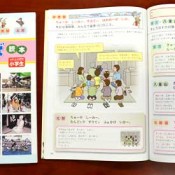
April 4, 2015 Ryukyu Shimpo
The Okinawa Prefectural Government (OPG) has for the first time published a booklet to help elementary and junior high students learn Shimakutuba – the local dialects of Okinawa. The booklets are designed for fifth-grade elementary school students and second-grade junior high-school students. On April 3, the OPG distributed them to schools across the prefecture. The OPG is asking schools to use the booklets during Japanese language lessons or in integrated study classes.
According to the government’s guidelines, fifth-grade elementary school students and second-grade junior high-school students can study the dialects along with the Japanese language. The OPG has published 36,000 copies at a cost of about 17.74 million yen. The OPG will publish the materials on its website in May. Mitsuyoshi Nohara, emeritus professor at Okinawa International University, supervised the booklet. It contains five local dialects used in Naha, Kush in Nago, Hirara in Miyako, four districts in Ishigaki-jima, and Sonai on Yonaguni Island. As more than five dialects are spoken in Okinawa, the books also have space for students to write down their own local dialects, if they are not already included. The booklet contains everyday vocabulary used in school life and is accompanied by a CD ROM.
An official of the OPG said, “The words published in this booklet do not represent all the Okinawan dialects. We hope students can use it to learn their own dialects at home.”
Naha City Government published a similar booklet which was delivered to all elementary and junior high-school students in the city in2013.
(English translation by T&CT)
Go to Japanese
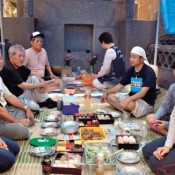
April 6, 2015 Ryukyu Shimpo
The Tomb Sweeping Festival called shimi started in various places in Okinawa on April 5. Many families visited the graveyards of their ancestors. At the Shikina-en in Naha, people offered various foods, including fruits and sweets to their ancestors. They reported their family news for the past year to their ancestors, and joined their hands in prayer for the health and prosperity of living family members.
Masakatsu Higa, 73, said, “The Tomb Sweeping Festival is a chance for us to exchange news and communicate with our ancestors in a spiritual manner. I spoke to them in prayer at the shimi festival today.” His elder brother Masataka, 75, younger brother Masatoshi, 67, and other family members, including children and grandchildren, also gathered at the family tomb.
Meanwhile, at the Ikemiya family tomb, 18 family members from four generations took part in the shimi. “I told the ancestors how my children and their family members were getting along. I prayed that we would have good health. There was a lot of hard preparation work for today, but I was pleased that it all went off successfully,” said Misako Ikemiya, 70.
(English translation by T&CT)
Go to Japanese
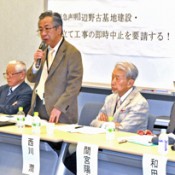
April 2, 2015 Ryukyu Shimpo
On April 1, 22 Japanese intellectuals, including Kenichi Miyamoto, emeritus professor at Osaka City University and the Nobel Prize winner, novelist Kenzaburo Oe, released a statement seeking an immediate stop to the reclamation work at Henoko, Nago. The governments of Japan and the United States are moving forward with construction of a U.S. air base to replace Marine Corps Air Station Futenma. The intellectuals stressed in the statement that the Okinawan people are clearly opposed to the construction of the new U.S. base.
They have encouraged others to sign the online petition. They aim to collect tens of thousands signatures which they will submit to the government.
Shunichi Teranishi, specially-appointed professor at Hitotsubashi University, and Osamu Nishitani, professor at Rikkyo University, who initiated this statement, held a press conference at the Upper House members’ building in Tokyo on April 1. They questioned the legitimacy of the environmental assessment – something required for the work to proceed – which had been signed by the previous governor of Okinawa. They also noted that the current governor, Takeshi Onaga, has set up an independent committee to examine whether that environmental assessment is still valid. They said that if the government proclaims itself democratic, it should suspend the reclamation works until the verification process is completed. They also asked the government to suspend any boring surveys.
In the statement, the intellectuals say they would fully support Governor Onaga if he were to cancel the permit allowing preparatory construction work on the Henoko seabed.
They sent the statement to Prime Minister Shinzo Abe on April 1. They plan to submit the online petition to the government on May 20.
This signature campaign can be found at http: //mcaf.ee./a2gd9
(English translation by T&CT)
Go to Japanese
April 2, 2015 Ryukyu Shimpo
The Island-Wide Council (Shimagurumikaigi) is to set up a fund as part of its campaign against the new U.S. base in Henoko. The money will be used to spread the message that public opinion in Okinawa opposes the Henoko relocation. The fund will help raise awareness of the issue in both mainland Japan and abroad.
The council will use the fund for advertisements in both American and Japanese national newspapers, as well as for symposiums on the Futenma issue in the U.S. The council hopes to recruit prominent personalities to lead the fund-raising.
Okinawa Governor Takeshi Onaga intends to visit the United States shortly after the end of April. It’s hoped an advertisement can be placed in U.S. newspapers to coincide with his visit.
Council Director, Yoshikazu Tamaki, a member of the Okinawa Prefectural Assembly, commented, “The purpose of the fund is not just to raise money. We hope our activities will also raise awareness of the Henoko issue among people in Japan and overseas.”
Shimagurumikaigi consists of civic groups, business people, assembly members and other groups and individuals who are against the Henoko relocation plan.
(English translation by T&CT and Hitomi Shinzato)
Go to Japanese
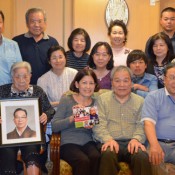
April 2, 2015 Ryukyu Shimpo
A third generation Okinawan from Hawaii has been getting to know his local relatives. Chris Chitose China met his second cousin 73-year-old Sadao for the first time in Yomitan on March 28. Chris’s grandfather and Sadao’s grandfather were brothers.
Chris and his wife Shaleen Takeko visited Okinawa to research his family tree. Chris said, “We are proud that we have a connection to Okinawa.”
They decided to visit after listening to stories from Chris’s brother who came here last year. He was the one who first discovered the family’s connection to Yomitan. Chris decided to follow in his brother’s footsteps and came to Okinawa to learn more about his roots. While here, he has discovered the China family tradition to insert the kanji “定” into the names of all the male children. He also saw took time to examine the family tree.
Chris said, “Because my last name looks like it might be pronounced ‘China’ in English, even though it is actually pronounced ‘Che-na’, I was told that my name might have originally come from China. I am so proud that I have roots in Okinawa and I am so happy to able to meet so many of my relatives during this visit.” Shaleen also has Japanese roots. Her ancestors are from Fukuoka Prefecture. She said, “Our eight-month-old grandchild’s middle name is Teijun. I am happy that I learned the origin of his name and our connection to the family in Okinawa.”
Sadao welcomed Chris and Shaleen with Okinawan food and said, “I remembered when I met Chris’s grandfather. It was very nice to hear stories of Hawaii and Okinawa.”
(English translation by T&CT and Megumi Chibana)
Go to Japanese
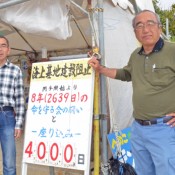
April 2, 2015 Ryukyu Shimpo
On April 1, citizens of a sit-in protest on Henoko beach marked 4,000 days since the sit-in began in 2004. It will mark the 11th anniversary on April 19. The protest began in response to a Japanese government marine boring survey, in preparation for the construction of a new U.S. air base. The protesting citizens brought the survey to a halt in 2005. The sit-in also began in front of the gate of U.S. Marine Camp Schwab from July 7, 2014. However, the central government restarted the boring survey last August. On average, about 70 to 100 people a day have visited the sit-in tent on the Henoko beach.
Hiroshi Ashitomi of the Helicopter Base Objection Association said, “We will never see the sit-in protest here reach 5,000 days.” Hatsuko Kinjo, a wife of the late Yuji Kinjo who was a representative of the “Save Life Association,” and a key player in local protests against the Henoko relocation, said, “My husband is supporting us from the other side. We want to resolve this issue.”
Another protester who has also passed away is Teruo Onishi of the Helicopter Base Objection Association. Hatsuko Kinjo said, “The local citizens mobilized themselves to set up this association, which has carried us to this point. I am proud of my husband.” Ashitomi added, “We have now reached a critical stage. By appealing to the international community, we will stop this unreasonable project.”
(English translation by T&CT)
Go to Japanese
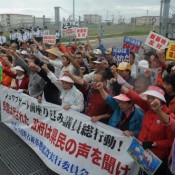
April 6, 2015 Ryukyu Shimpo
A protest by 84 people, including members of Japan’s national parliament, took place in front of the gate at U.S. Marine Camp Schwab on April 4. The protesters called for a halt to the construction of a new base. The demonstration was organized by the Committee to Stop New U.S. military Base Construction in Henoko, which consists of assembly members and citizens groups opposing the relocation of U.S. Marine Corps Air Station Futenma to the Henoko district of Nago.
The protesters gathered at the gate at around 7 a.m., and shortly after began voicing their opposition to the construction. As well as two Okinawa Prefectural Assembly members and three Ishigaki City Assembly members, three of Okinawa’s Diet representatives also took part. They were Seiken Akamine (the Communist Party), Denny Tamaki (Seikatsu no To : People’s Life Party ), and Keiko Itokazu (independent).
Two more protests are planned at the same location for April 7 and 8.
The politicians also plan to take part in a rally at Okinawa’s Cellular Stadium, Naha, on May 17, which is expected to attract around 10,000 people.
Workers employed by the Okinawa Defense Bureau did not carry out work from marine construction barges or from a crane barge on the morning of April 6. On the same date, 10 canoes carrying protesters were surrounded by the Japan Coast Guard in eleven inflatable boats.
(English translation by T&CT)
Go to Japanese
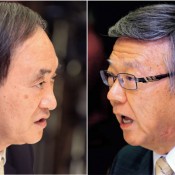
April 6, 2015 Ryukyu Shimpo
The Chief Cabinet Secretary Yoshihide Suga and Okinawa Governor Takeshi Onaga have held a stormy meeting at a Naha hotel. Suga said, “Giving up Henoko relocation could lead to Futenma Air Station becoming a permanent fixture. Based on applicable laws and regulations approved by the former Governor Hirokazu Nakaima, we are carrying out the landfill without making a fuss.” Onaga responded, “Although the chief cabinet secretary repeatedly used the word ‘without making a fuss,’ it reminds me of the third High Commissioner of the U.S. Civil Administration of the Ryukyu Islands, General Paul Caraway who refused to allow Okinawans any increase in self-rule or autonomy.” Onaga strongly criticized Suga, saying, “That attitude fuels the anger of the Okinawan people and makes it impossible to build a new U.S. military base in Henoko.”
The April 5 talks, part of which were open to the public, is the first time that Suga and Onaga have met face-to-face since Onaga won the gubernatorial election in December 2014. A major platform of his campaign was a pledge to stop the relocation of U.S. Marine Corps Air Station Futenma to the Henoko district of Nago.
At the beginning of the meeting, Suga talked about how the Japanese government had been working to reduce Okinawa’s burden, (in terms of the island hosting so many US bases.) He also spoke about plans to promote the island. He said, “We would like to work together with the Okinawan people and we would like the people to trust us once again.”
Onaga said, “The difference between me and the former governor comes down to the approval of the Henoko landfill. The decision to approve the reclamation was a major issue in the last gubernatorial election. My victory in that election by a margin of 100,000 votes shows the overwhelming opposition felt by the Okinawan people to the Henoko relocation plan.”
Onaga told Suga that he understood the importance of the Japan-U.S. security arrangements. However, he added, “The U.S. military forcibly took over Okinawan land to build bases, which continues to bring huge sufferings to the people today. The Japanese government claims that Okinawa should bear the burden of hosting a new base because Futenma Air Station is the world’s most dangerous base. If Okinawan people oppose it, the Japanese government blames Okinawans for not thinking about the importance of Japan’s security.” Onaga continued, “The fact the Japanese government is making such an unreasonable demand clearly shows how low Japanese politics has sunk.”
Onaga went on to say that if the Henoko relocation was cancelled, the Japanese government would be responsible for what happened next, “You and the former U.S. Secretary of Defense Donald Rumsfeld said that Futenma Air Station is the most dangerous base in the world. I would like to know whether the base will become a permanent fixture if the Henoko relocation does not work.”
Onaga intends to keep the conversation going with the central government while at the same time considering how best to exercise his powers as governor. This may result in him cancelling his predecessor’s order to approve construction work on the Henoko seabed.
The Naha meeting lasted an hour. During the 30 minute closed-door portion, Onaga and Suga exchanged opinions without the presence of their administrative officers.
(English translation by T&CT)
Go to Japanese
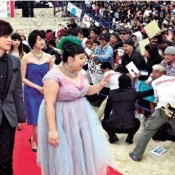
March 26, 2015 Ryukyu Shimpo
On March 25, the 7th Okinawa International Movie Festival, “Laugh & Peace” opened at the Tropical Beach in Ginowan.
Appearing on the red carpet, marking the festival’s opening, were Okinawan comedy duo Garage Sale, other comedians, idols, actors and actresses. Fans who had flocked to see the stars, enjoyed getting their autographs and having photos taken with them.
The festival screened 19 community-based movies, including five shot in Okinawa, along with Japanese and foreign movies which have yet to be released here. The event also saw popular comedians, idols and artists performing on stage. Two red carpet events took place for the first time at Gate Street in Okinawa City on March 28, and at Kokusai Street in Naha the following day.
Fourteen-year-old Akari Oshiro who waited for five hours for the event to start said, “I was very happy to see the comedy duo 8.6 seconds Bazooka.”
The festival ended on March 29.
(English translation by T&CT, Hitomi Shinzato)
Go to Japanese
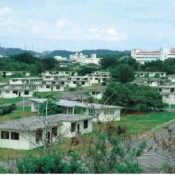
April 1, 2015 Ryukyu Shimpo
On March 31, the U.S. military returned to Japan a 51-hectare housing area at Camp Zukeran (West Futenma Housing area) in Ginowan. This is part of a 2013 agreement between the governments of the two countries to reduce the U.S. military presence south of Kadena airbase. It is the second land return under the agreement, following the handover of 1 hectare in the Makiminato Service Area in August 2013.
The Okinawa Defense Bureau will start to remove buildings and carry out a soil pollution survey on the returned land in April. It’s expected to take years before the land is actually handed back to its owners. Ginowan City Municipal Government says it will make its plan for the returned land by July. The council is currently working with the landowners and the central and prefectural governments to gain a consensus about how the area should be used. There are plans to move Ryukyu University Hospital to the site and build a heavy particle radiotherapy facility for cancer treatment there.
The Ginowan City Military Landowners’ Association revised its bylaw at an extraordinary meeting held on March 31, to allow the 537 landowners affected by the return of the site to remain members. The association will negotiate on behalf of the landowners regarding the price of the land.
Shinich Matayoshi, the president of the association, said, “We would like to convey the wishes of the landowners to the other stakeholders.”
(English translation by T&CT)
Go to Japanese










 Webcam(Kokusai Street)
Webcam(Kokusai Street)


